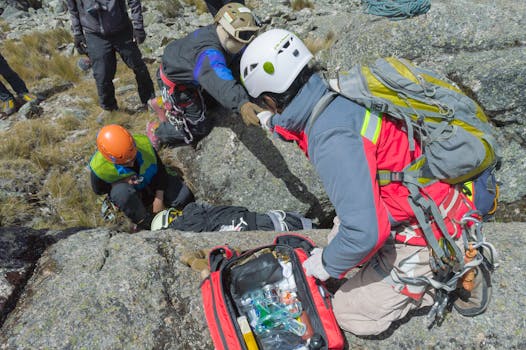Climbing, an exhilarating blend of adventure and physical challenge, attracts millions of enthusiasts across the United States. While the thrill of scaling new heights is unmatched, it’s essential to be aware of the risks involved.
Understanding climbing injuries not only helps in preventing them but also equips climbers to respond appropriately when accidents occur. Education on this topic is valuable for both amateur and seasoned climbers.
This article delves into the types, causes, prevention, and management of climbing injuries. Through comprehensive insights, it aims to empower climbers to enjoy their experience while minimizing risks.
Types of Climbing Injuries
Climbing injuries can vary significantly in type and severity, affecting different parts of the body. Common injuries range from sprains and strains to fractures and dislocations.
Overuse injuries, such as tendonitis, are prevalent among climbers due to repetitive motions and high stress on particular muscle groups. Understanding these injuries is crucial for prevention.
Acute injuries often occur suddenly, typically resulting from falls or slips. These injuries require immediate attention and vary from mild sprains to severe fractures.
Moreover, psychological injuries like anxiety can arise from high-stress situations. These need consideration, as mental health plays a role in performance and safety.
Lastly, lack of conditioning or incorrect technique can lead to injuries. Knowing the types helps climbers identify risks and make informed choices during their adventures.
Common Overuse Injuries
Overuse injuries are particularly common in climbing, often developing slowly over time. They result from repetitive actions that lead to micro-tears in muscles and tendons.
Tendinitis, especially of the elbow or shoulder, is a frequent issue. It manifests from continuous strain and can hinder performance if not addressed promptly.
Another common overuse injury is finger pulley injuries, affecting climbers upon gripping holds. These injuries can sideline climbers for extended periods, requiring rest and rehabilitation.
Shoulder injuries are also prevalent, often stemming from improper technique or insufficient warm-up. Strengthening exercises can play a significant role in preventing these injuries.
Overall, recognizing the signs of overuse injuries can help climbers adjust their training and technique. Early intervention often leads to better outcomes.
Acute Injuries and Their Management
Acute injuries require immediate attention to prevent further damage. These injuries often occur during falls or abrupt movements, leading to severe discomfort.
Common acute injuries include ankle sprains, fractures, and dislocations. Immediate first aid is crucial to stabilize the injury and reduce pain and swelling.
Applying the R.I.C.E. method—Rest, Ice, Compression, Elevation—provides initial care and can aid recovery. Knowing this technique prepares climbers for emergencies.
Seeking medical assistance is vital for severe injuries, such as fractures. Professional evaluation ensures appropriate treatment and rehabilitation, which is essential for a full recovery.
In summary, a swift response to acute injuries significantly enhances recovery. Awareness of symptoms and proper management strategies are crucial in climbing.
Risk Factors in Climbing Injuries
Understanding risk factors plays a vital role in injury prevention during climbing. Factors can be categorized into intrinsic and extrinsic elements contributing to climbing injuries.
Intrinsic factors include a climber’s physical condition, flexibility, and previous injuries. Climbers with a history of injuries are more susceptible to re-injury.
Extrinsic factors relate to the environment and equipment used. Poorly maintained gear or climbing routes can dramatically increase the risk of accidents.
Additionally, weather conditions may influence safety as wet or icy holds increase the likelihood of falls. Climbers must assess their surroundings before embarking on a climb.
By recognizing and mitigating these risk factors, climbers can create a safer climbing environment, enhancing both enjoyment and performance.
Prevention Strategies for Climbing Injuries
Preventing climbing injuries involves a proactive approach, emphasizing training, technique, and proper equipment. A well-structured training plan is essential for climbers at all levels.
Incorporating strength and flexibility exercises enhances physical conditioning. A well-rounded routine prepares the body for the demands of climbing and lowers the injury risk.
Understanding proper climbing techniques is vital. Utilizing correct footwork and body positioning not only improves performance but also minimizes excessive strain on muscles.
Additionally, using appropriate gear tailored to the specific climbing type significantly increases safety. Regular checks and maintenance of equipment ensure reliability and reduce risk.
Ultimately, continuous learning and preparation are key components in injury prevention. A cautious approach fosters a safer and more enjoyable climbing experience.
Rehabilitation After an Injury
Recovering from a climbing injury requires patience and a well-structured rehabilitation plan. Setbacks can be frustrating, but a gradual approach ensures long-term recovery and strength.
It’s essential to follow a healthcare professional’s recommendations during recovery. They may suggest physical therapy and specific exercises to build strength and restore flexibility.
Listening to one’s body is crucial. Pushing through pain can lead to re-injury, hindering progress. Climbers must allow adequate time for recovery before resuming activities.
Cross-training is a beneficial strategy during rehabilitation. Engaging in low-impact activities helps maintain fitness levels while allowing injured areas to heal.
Ultimately, proper rehabilitation not only aids recovery but also prepares climbers for a safe return to the sport. A strong foundation leads to future resilience.
Conclusion
Understanding climbing injuries is an integral aspect of enjoying the sport to its fullest. By recognizing various types of injuries and actively implementing prevention strategies, climbers can create a safer experience.
Additionally, knowing how to manage acute and overuse injuries equips climbers for speedy recovery, enhancing resilience to future challenges. Education and preparation are invaluable tools.
Ultimately, a commitment to safety, technique, and continuous learning fosters a fulfilling climbing journey. Embracing a thoughtful approach ensures that climbing remains a vibrant and exhilarating pursuit.

